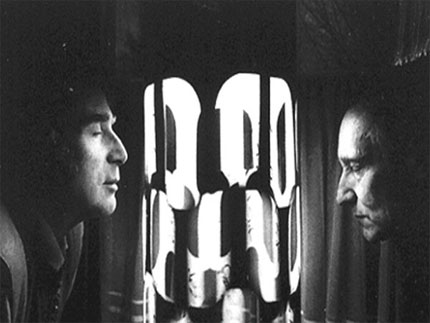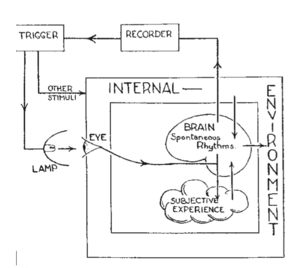User:Stonestone/secondessayfort2stone: Difference between revisions
Stonestone (talk | contribs) |
Stonestone (talk | contribs) |
||
| Line 4: | Line 4: | ||
Space-out is a feeling that people can never tell exactly what is by themselves which can be seen as the soul leaving the body. The views that people see in front of them when their minds escape from their bodies, are diverse and different from the others and difficult to tell clearly. However, the trigger points of space-out are quite similar, drugs, alcohol even some specific visuals, for example. Dreamachine, as one of the most critical patent of triggering space-out, also known as a piece of art work, is a good example to explore the phenomenon of space-out. In this essay, I will give my research on how dreamachine make efforts on people and why people get the feeling of space-out. | Space-out is a feeling that people can never tell exactly what is by themselves which can be seen as the soul leaving the body. The views that people see in front of them when their minds escape from their bodies, are diverse and different from the others and difficult to tell clearly. However, the trigger points of space-out are quite similar, drugs, alcohol even some specific visuals, for example. Dreamachine, as one of the most critical patent of triggering space-out, also known as a piece of art work, is a good example to explore the phenomenon of space-out. In this essay, I will give my research on how dreamachine make efforts on people and why people get the feeling of space-out. | ||
===Flicker=== | ===Flicker=== | ||
“Flicker” is a long-standing term of art in experimental psychology, referring to visual effects induced by flickering lights. In 1945, Dr. W. Grey Walter applied flicker into his EEG research, in the end an electronic stroboscope was invented. After an experiment in a big range of people, Dr Walt got the feedbacks (strange feelings) from samples he chose, which were:" faintness or swimming in the head"; "unresponsive or unconscious for a few moments"; "the limbs jerked in rhythm with the flashes of light."<br /> Most of the feedback pointed into epileptic symptoms. | “Flicker” is a long-standing term of art in experimental psychology, referring to visual effects induced by flickering lights. In 1945, Dr. W. Grey Walter applied flicker into his EEG research, in the end an electronic stroboscope was invented. After an experiment in a big range of people, Dr Walt got the feedbacks (strange feelings) from samples he chose, which were:" faintness or swimming in the head"; "unresponsive or unconscious for a few moments"; "the limbs jerked in rhythm with the flashes of light."<br /> Most of the feedback pointed into epileptic symptoms.<br /> | ||
A feedback apparatus was built in order to figure out how the flicker trigger works on our brain. [[File:t2pic01.png|300px|right|V. J. Walter and W. G. Walter, “The Central Effects of Rhythmic Sensory Stimulation,”]]<br /> | |||
As shown in the diagram on the right, eyes receive the lights from flicker (lamp) as an subjective experienced signal which is transmitted to our brain, then, the signal goes through the recorder and stimulates the trigger, continues the loop again. This loop can be seen as the basic prototype of how the visual flicker we look at, works on our brain.<br /> | |||
[[File:t2pic01.png|300px|right|V. J. Walter and W. G. Walter, “The Central Effects of Rhythmic Sensory Stimulation,”]] | |||
===Dreamachine=== | ===Dreamachine=== | ||
Revision as of 13:07, 13 April 2016
Dreamachine -- To Create Space-Out
Introduction
Space-out is a feeling that people can never tell exactly what is by themselves which can be seen as the soul leaving the body. The views that people see in front of them when their minds escape from their bodies, are diverse and different from the others and difficult to tell clearly. However, the trigger points of space-out are quite similar, drugs, alcohol even some specific visuals, for example. Dreamachine, as one of the most critical patent of triggering space-out, also known as a piece of art work, is a good example to explore the phenomenon of space-out. In this essay, I will give my research on how dreamachine make efforts on people and why people get the feeling of space-out.
Flicker
“Flicker” is a long-standing term of art in experimental psychology, referring to visual effects induced by flickering lights. In 1945, Dr. W. Grey Walter applied flicker into his EEG research, in the end an electronic stroboscope was invented. After an experiment in a big range of people, Dr Walt got the feedbacks (strange feelings) from samples he chose, which were:" faintness or swimming in the head"; "unresponsive or unconscious for a few moments"; "the limbs jerked in rhythm with the flashes of light."
Most of the feedback pointed into epileptic symptoms.
As shown in the diagram on the right, eyes receive the lights from flicker (lamp) as an subjective experienced signal which is transmitted to our brain, then, the signal goes through the recorder and stimulates the trigger, continues the loop again. This loop can be seen as the basic prototype of how the visual flicker we look at, works on our brain.
Dreamachine
Space-out
Brainwaves
Visual Speed
Nosebleed
Conclusion
Reference
Nic Sheehan, Flicker, 1997, Documentary, 1:12:02
B.C. ter Meulen D. Tavy B.C. Jacobs, From Stroboscope to Dream Machine: A History of Flicker-Induced Hallucinations, Eur Neurol 2009 pp316–320
Thomas Budzynski, Ph. D., The Clinical Guide to Sound and Light, 2006
David Siever The Application of Audio-Visual Entrainment for the Treatment of Seniors 2004
Luciana Haill ICT & Art Connect : Revelations by Flicker, Dreamachines and Electroencephalographic Signals in Art
http://www.permuted.org.uk/Flickers.htm
http://www.slideshare.net/holcombea/uws-june2013for-slideshare
Space-Out Experience
Brain Waves
- Brief introduction of 4 types of brain waves
- Alpha wave
- Lucid Dream (My personal opinion of Space-out)
- Examples of people's experiences/facts
Dreamachines
In 1960s, the artist Brion Gysin invented Flicker which is also known as Dreamachine, a stroboscopic flicker device that produces visual stimuli. The dreamachine was made from a cylinder with holes in different shapes and sizes in the sides, with a light bulb in the centre of the cylinder. Putting on the record turntable, rotating at 78 or 45 revolutions per minute, allows the light to come out from the holes at a constant frequency of between 8 and 113 pulses per second. This range corresponds to alpha waves, electrical oscillations normally present in the human brain while relaxing.

From one of Brion's diary reports in 1958, he wrote that he had been sleeping on a bus, leaning with his head against the window pane. On passing by a row of trees, sunlight came flickering through and he started to hallucinate:
''An overwhelming flood of intensely bright patterns in supernatural colours exploded behind my eyelids: a multi-dimensional kaleidoscope whirling out through space. The vision stopped abruptly when we left the trees. Was that a vision?''
COMMENTS: the poet Allen Ginsberg wrote about the Dreamachine: ‘I looked into it – it sets up optical fields as religious and mandalic as the hallucinogenic drugs – it’s like being able to have jewelled biblical designs and landscapes without taking chemicals’

